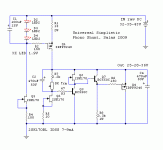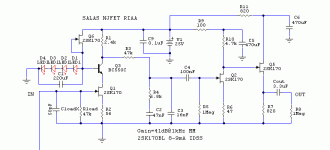Hi Salas,
Not sure of that...it is a B1 with LDR volume control. Will try afterall.
It wasn't George's circuit and also using different LDRs.
Turn your LDR to max and measure kOhm with your DVM on its input RCA. Turn off your main amplifier first. Then we will know.
Yes, an indicative average would do, for deciding the adequate coupling value.
Clean as paradise but major PITA this light thing eh? I will make one soon so to evaluate personally though. But I would like to get it up to 50k. Maybe by utilizing some CCS control for the LDRs if I am in the mood.
Clean as paradise but major PITA this light thing eh? I will make one soon so to evaluate personally though. But I would like to get it up to 50k. Maybe by utilizing some CCS control for the LDRs if I am in the mood.
Universal Phono Versions Shunt
Given the wealth of reg manipulation ideas* and the 3 established final phono versions, I decided to do some subjective evaluations specifically with the simplistic phono as the load so to explore. Went back and forth, and felt that some minimal additions work to a good point when more can lead to alterations that work against the genuine signature of the Simplistic NJFET RIAA - Simplistic Shunt combo. We have seen some erratic noisy Zeners along the way in the thread, also some cartridge changes necessitating version jumps. So I though its better to combine flexibility and some knowledge from my subjective tests, into one Universal Simplistic Shunt schematic, able to cater for all 3 versions without Vref substitutions, just variable with a trimmer. Additional benefit is the precise B+ voltage matching ability between channels for those who make individual shunts for channels, and a little play test of B+ +/-1V for those not equipped for measuring THD so to decide their subjectively favorite operating point. I would prefer the multiturn trimmer to be substituted for a steady resistor after setting and testing long enough, securing long term reliability and assurance against the possibility of the miniature wiper becoming noisy. That's the heart of the VarVref after all.
So with this one you fit all versions and its enhanced too. Enjoy.
*Special credit to Ikoflexer. I incorporated only a bit of the countless ideas he explores.
Given the wealth of reg manipulation ideas* and the 3 established final phono versions, I decided to do some subjective evaluations specifically with the simplistic phono as the load so to explore. Went back and forth, and felt that some minimal additions work to a good point when more can lead to alterations that work against the genuine signature of the Simplistic NJFET RIAA - Simplistic Shunt combo. We have seen some erratic noisy Zeners along the way in the thread, also some cartridge changes necessitating version jumps. So I though its better to combine flexibility and some knowledge from my subjective tests, into one Universal Simplistic Shunt schematic, able to cater for all 3 versions without Vref substitutions, just variable with a trimmer. Additional benefit is the precise B+ voltage matching ability between channels for those who make individual shunts for channels, and a little play test of B+ +/-1V for those not equipped for measuring THD so to decide their subjectively favorite operating point. I would prefer the multiturn trimmer to be substituted for a steady resistor after setting and testing long enough, securing long term reliability and assurance against the possibility of the miniature wiper becoming noisy. That's the heart of the VarVref after all.
So with this one you fit all versions and its enhanced too. Enjoy.

*Special credit to Ikoflexer. I incorporated only a bit of the countless ideas he explores.
Attachments
Nice Idea, Salas, but I cannot understand why you added Q7 and the associated R8 to the shunt v.1.
Moreover, C2 could be a good, but std elcap or must be a "premium" one as C4?
Q7 proved good for opening it up and focusing it a little more, but only when resistive loaded (R8). When I tried an active load, tone tightened up strongly in the wrong way. Its function is to drive better the shunt Mosfet's capacitive gate, and extends the flat low output impedance beyond the audio band. That subjective finding follows the simulation indications. Its not a spectacular subjective change per se, and maybe not translating in higher signal level like in line preamps with superior PSRR, but noticeable IMHO. This phono needs the least interaction between stages due to the fragile signal level and low PSRR. Low and flat reg impedance goes towards that goal. All in all this Universal has secure Vref against self noise, sports variability, better shunt gate drive, and it passed hands on test. If you don't use Q7 and R8 it will work perfectly by connecting directly from Q3 collector to R6. You can judge yourself by adding those 2 components and evaluating. Hey, its fun also. And yes, C2 must be good as Rcruz has elaborated not long ago.
I don't know the LDR hands on. Normally some line input measures some kOhm with a DVM no matter the technology inside.
Anyway, if 10uF proved passing the audio range as low as you know with your speakers and room with other preamps too, then that value should be adequate.
Anyway, if 10uF proved passing the audio range as low as you know with your speakers and room with other preamps too, then that value should be adequate.
Hi, I'd like to build the attached circuit for MM and high output MC (like DL160) and have a few questions:
How much mA will one channel draw?
Q1, Q2 and Q5 have to be matched L/R, but not Q3 and Q6, right? So essentially three pairs of the 2SK170BL plus two unmatched 2SK170BL/BC550C are needed..or not?
The circuit is non-inverting, right?
Why not 47n6 and 15n9 in the RIAA network but 47n and 16n?
With a "preamp" (B1) with 25k input impedance can I use a 2u7 coupling-cap or should I use 3u3 anyway?
Thanks a lot, Dave
How much mA will one channel draw?
Q1, Q2 and Q5 have to be matched L/R, but not Q3 and Q6, right? So essentially three pairs of the 2SK170BL plus two unmatched 2SK170BL/BC550C are needed..or not?
The circuit is non-inverting, right?
Why not 47n6 and 15n9 in the RIAA network but 47n and 16n?
With a "preamp" (B1) with 25k input impedance can I use a 2u7 coupling-cap or should I use 3u3 anyway?
Thanks a lot, Dave
Attachments
in a single channel, none of the transistors need to be matched. All of them should be within the designer's specification.
In a stereo pair, you are right that corresponding devices should be close in specification, but I doubt that matching is required.
The performance should be independent of small changes in parameters of the active devices.
I would select devices that are close in spec for all the active devices.
In a stereo pair, you are right that corresponding devices should be close in specification, but I doubt that matching is required.
The performance should be independent of small changes in parameters of the active devices.
I would select devices that are close in spec for all the active devices.
Rodeodave:
In a stereo pair you need to match the gain well and the THD roughly. Simply idss matched per position per channel, but all falling in the 8-9mA bracket is what is needed. Also, don't change the riaa values. It will subjectively detune from intended, more than you may think. For HiMC you better build the 48dB gain version. With a B1, your amp should be 0.5V sensitive to be driven full power with a Denon110/160-HiMcSimpl.-B1. Stick with 3u3 cap. Non inverting is the cct, yes.
In a stereo pair you need to match the gain well and the THD roughly. Simply idss matched per position per channel, but all falling in the 8-9mA bracket is what is needed. Also, don't change the riaa values. It will subjectively detune from intended, more than you may think. For HiMC you better build the 48dB gain version. With a B1, your amp should be 0.5V sensitive to be driven full power with a Denon110/160-HiMcSimpl.-B1. Stick with 3u3 cap. Non inverting is the cct, yes.
Hello All,
Salas I followed you over to this thread from the GB for the Direct Coupled B-1 Buffer with shunt Reg by Salas thread. Good work times two.
I have been operating in a vacuum here (yes pun intended). I been using vacuum tube and a Haggerman Bugle RIAA amplifiers. Turned up way to loud to listen to the Tubes have hiss. The Bugel has less hiss but I do not like the quality of the sound next to the tubes. I purchased extra parts for the B-1 with shunt, enough to build your Simple RIAA. This is not the search for the Holy Grail, it is just for fun.
Two questions for the community: Has anyone operated the Salas Simple RIAA amplifier connected to the Coupled B-1 Buffer with shunt Reg by Salas, results? Second question, has any one done any bench testing of S/N ratios of the tube, Op-Amp and 2SK170 based RIAA amplifiers, results? The second question is the operating in a vacuum part, not knowing what to expect as far as noise/hiss goes.
DT
All Just for Fun!
Salas I followed you over to this thread from the GB for the Direct Coupled B-1 Buffer with shunt Reg by Salas thread. Good work times two.
I have been operating in a vacuum here (yes pun intended). I been using vacuum tube and a Haggerman Bugle RIAA amplifiers. Turned up way to loud to listen to the Tubes have hiss. The Bugel has less hiss but I do not like the quality of the sound next to the tubes. I purchased extra parts for the B-1 with shunt, enough to build your Simple RIAA. This is not the search for the Holy Grail, it is just for fun.
Two questions for the community: Has anyone operated the Salas Simple RIAA amplifier connected to the Coupled B-1 Buffer with shunt Reg by Salas, results? Second question, has any one done any bench testing of S/N ratios of the tube, Op-Amp and 2SK170 based RIAA amplifiers, results? The second question is the operating in a vacuum part, not knowing what to expect as far as noise/hiss goes.
DT
All Just for Fun!
- Home
- Source & Line
- Analogue Source
- Simplistic NJFET RIAA

